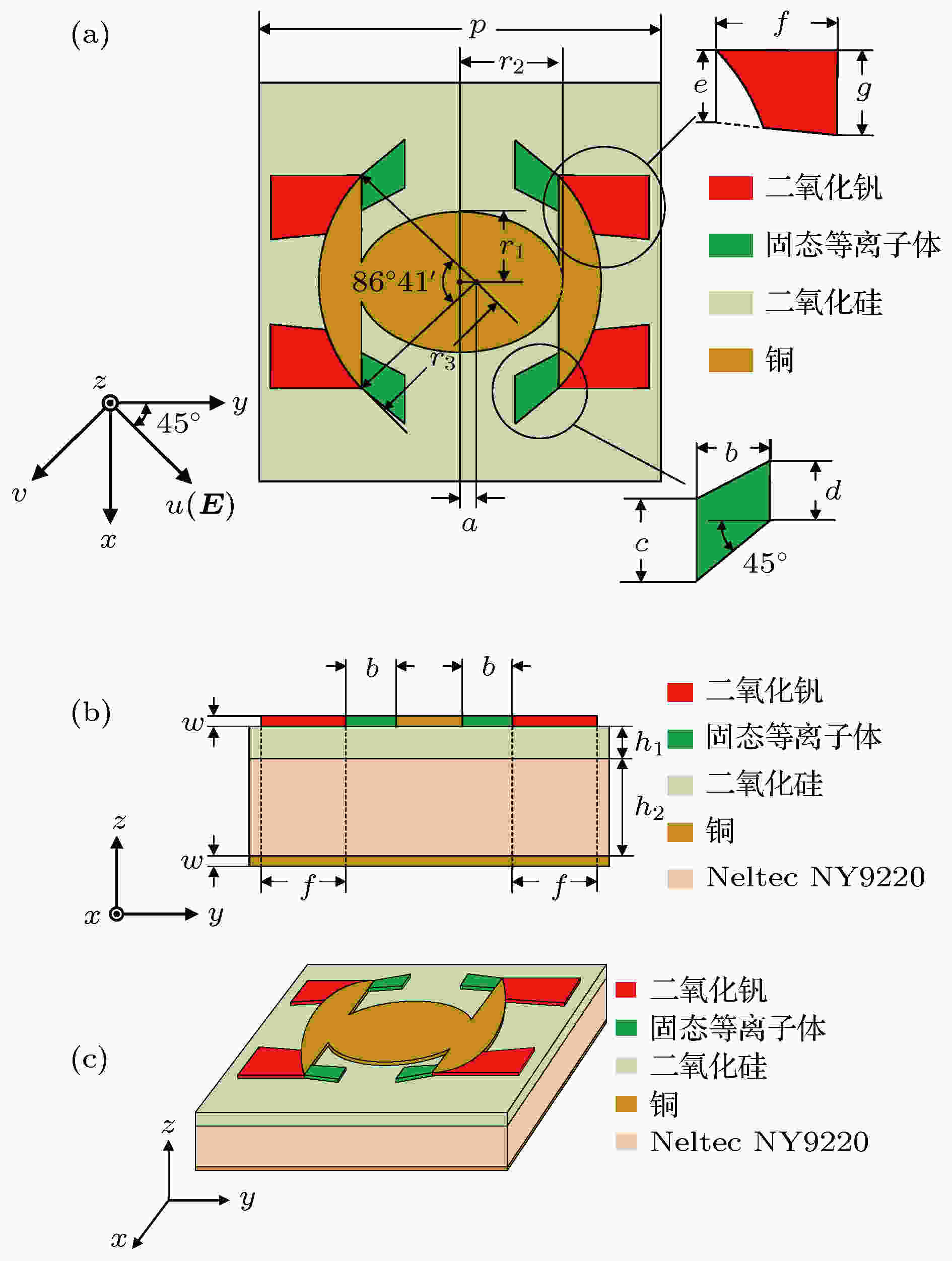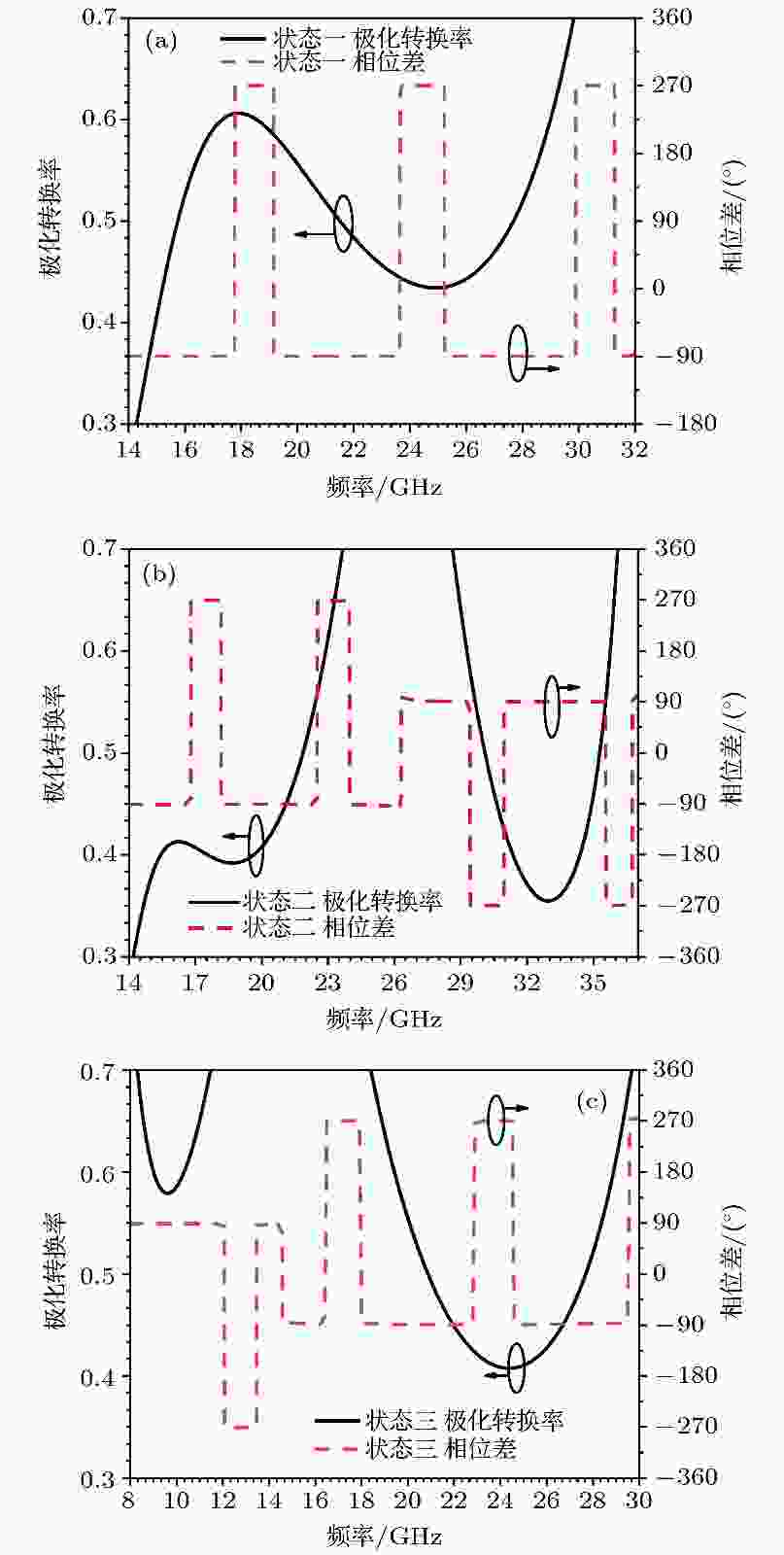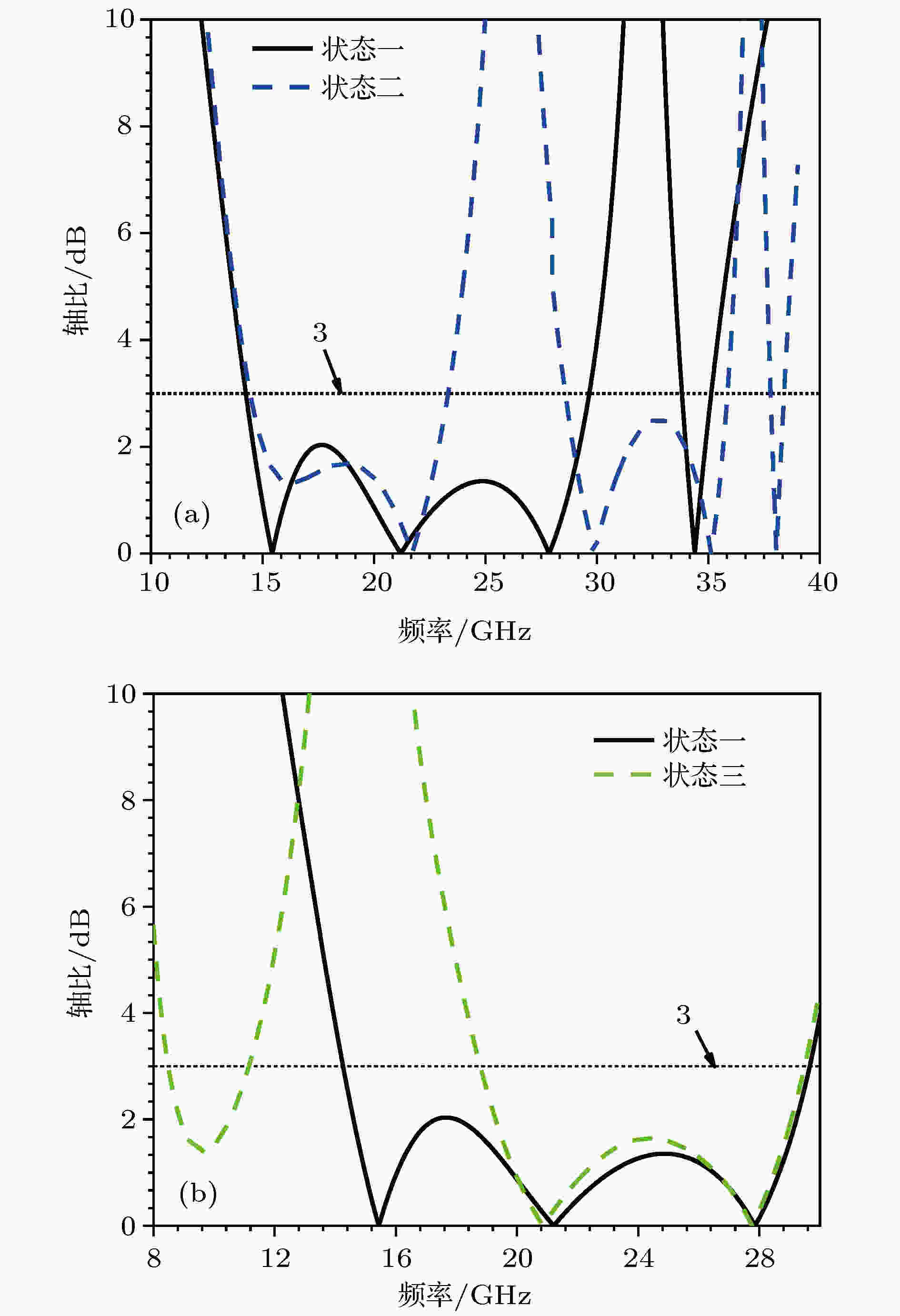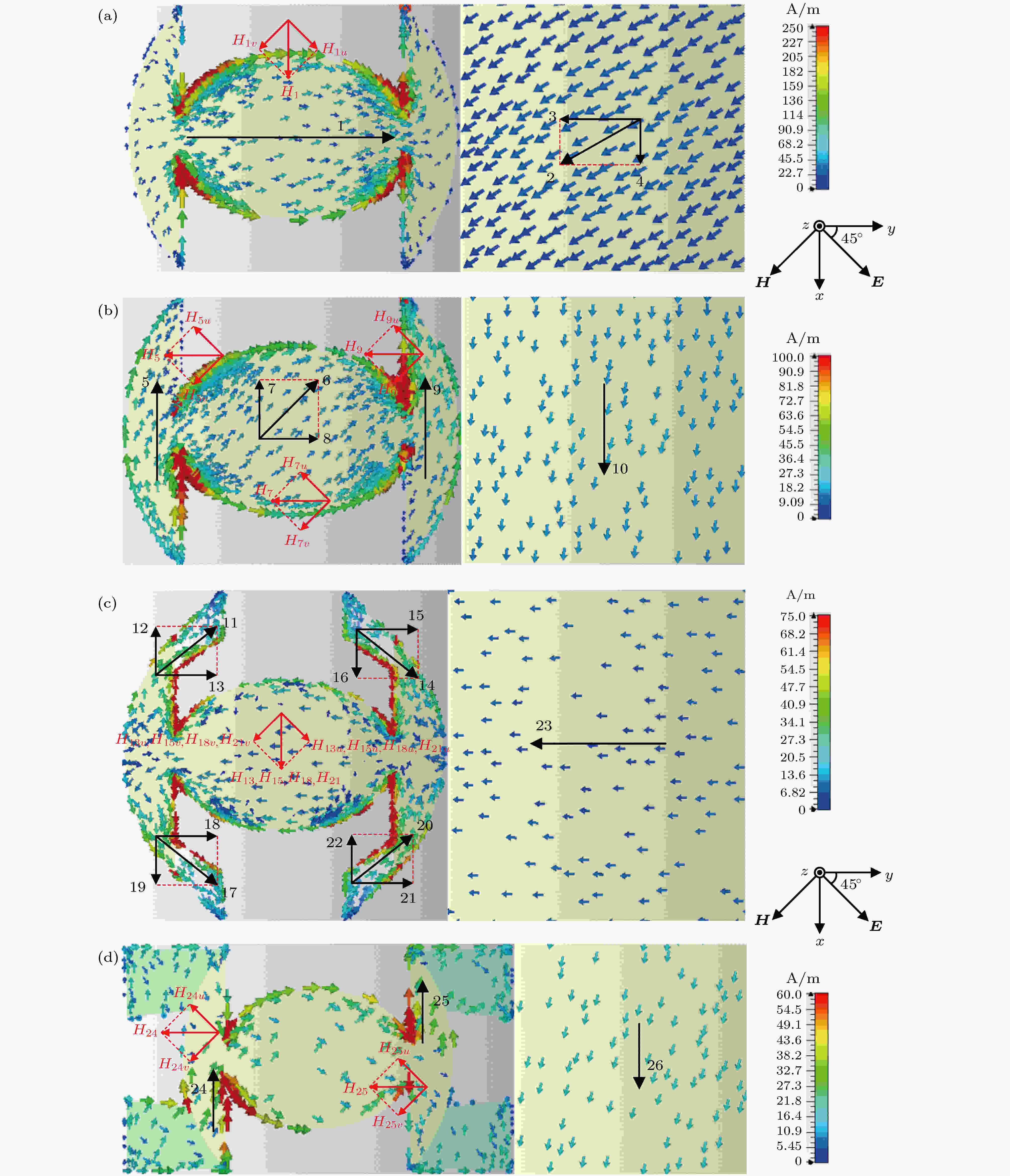全文HTML
--> --> -->尽管超表面极化转换器有着许多先天的优势, 但现在超表面极化转换器在功能上大多为线极化波转换线极化波, 如: 南京航空航天大学的杨化[3]在9.5—15.41 GHz的频段内实现了极化转换率大于90%的交叉线极化转换. Cheng等[4]实现了太赫兹波段内超宽带交叉线极化转换. 而在实现线-圆极化转换方面, Su等[5]利用开口矩形环实现了多频点线-圆极化转换; Ma等[6]采用了两个交叉摆放的“工”形结构实现了9.2—11.0 GHz内的宽带线-圆极化转换, 但有关超宽带线-圆极化转换器的报道并不多见. 并且, 一旦超表面极化转换器结构固定后, 其工作频带通常无法调整, 难以实现小型化和集成, 因此通常需要引入新颖可调谐材料来实现工作频带的动态调控.
固态等离子体是一种可调谐的材料, 它具有优良导电性[7]、快速重构性[8]等一系列物理特性. 一方面, 固态等离子体的物理特性能够通过外部可编程逻辑阵列进行调控. 当固态等离子体未被激励时, 其表现为介质特性; 当固态等离子体被激励时, 表现为金属特性. 因此固态等离子体能用于设计可调谐的功能性器件[9,10]. 另一方面, 二氧化钒(VO2)因具有随温度变化的相变特性而备受人们关注. VO2在温度小于68 ℃[11]时可视为绝缘相, 表现为介质特性; 而在温度大于68 ℃时可视为金属相, 体现为金属特性. 同时, VO2具有相变过程可逆[12]、相变速度快[13]等物理特性, 使得VO2在设计吸波器[14,15]、开关[16,17]、天线[18]等器件方面有着极其广泛的应用前景.
但单一的调控手段所能达到的调控性能效果经常受限于外界环境和可调控器件对单一物理场的响应程度, 难以适应当今技术发展的要求. 而多物理场调控器件, 其调控手段更加多样, 对于单一器件而言, 能对更加复杂的外界环境做出多种响应, 例如: Cai等[19]利用VO2与金属非对称开口谐振环结合, 设计了一种多功能可调谐复合超表面, 通过加热和施加电流两种方式实现对透射太赫兹波的振幅调控. 因此多物理场调控方式为未来的极化转换器、吸波器、电子开关、光学存储器件等的研究与设计提供了一种新思路.
本文结合固态等离子体和VO2的各自的优势设计了一款能够工作在微波波段内的反射式线-圆极化转换器, 并且能够通过多个物理场对其工作频段进行调控, 可以采用电控和温控两种手段使该线-圆极化转换器呈现三种工作状态, 采用电控手段(切换工作状态一与工作状态二)可以实现线-圆极化转换工作频带向高频段转移; 采用温控手段(切换工作状态一与工作状态三)可以实现线-圆极化转换工作频带向低频段转移. 合理的参数优化可以使得圆极化的频带动态调控范围横跨4个波段: X波段、Ku波段、K波段和Ka波段.
| 参数/mm | 数值 | 参数/mm | 数值 | |
| a | 0.2417 | h1 | 1.5 | |
| b | 0.48 | h2 | 0.5 | |
| c | 0.47 | p | 4.8 | |
| d | 0.35 | r1 | 0.81 | |
| e | 0.68 | r2 | 1.1583 | |
| f | 1.2 | r3 | 1.87 | |
| g | 0.8 | w | 0.018 |
表1线-圆极化转换器的参数
Table1.Parameters of linear-to-circular polarization converter.
 图 1 线-圆极化转换器结构单元示意图 (a)正视图; (b)侧视图; (c)立体图
图 1 线-圆极化转换器结构单元示意图 (a)正视图; (b)侧视图; (c)立体图Figure1. Structure schematic of the unit cell for linear-to-circular polarization converter: (a) Front view; (b) side view; (c) stereogram.
“梯形”固态等离子体由PIN单元组成的阵列实现, PIN单元之间有隔离层进行隔离, 如图1(a)所示. 固态等离子体构成的谐振单元通过激励PIN单元阵列实现, 采取临近耦合串馈的方式, 通过两条长条状微带耦合馈线进行馈电, 从而对固态等离子体谐振单元两端加载偏置电压进行激励[20]. 未激励时固态等离子体谐振单元表现出介质特性, 即为未激励状态; 激励时表现为金属特性, 即为激励状态. 采用Drude模型来描述其介电常数[21], 如(1)式所示:



同时, 还可以采用电导率[20]来描述其物理特性, 如(2)式所示:



对于缺口直角梯形VO2, 可用电导率来描述其物理特性[22,23]. 当温度T < 68 ℃时, VO2为绝缘态, 表现为介质特性, 采用在T = 50 ℃时的电导率10.62 S/m来等效VO2绝缘态的电导率; 当温度T ≥ 68 ℃时, VO2为金属态, 表现为金属特性, 采用在T = 80 ℃时的电导率2.76 × 105 S/m来等效VO2金属态的电导率[24].
本文所有结果均由全波仿真软件HFSS (high frequency structure simulator)仿真得出, 在进行仿真时, 电磁波沿–z轴方向垂直入射, 电场E沿u轴方向(与x轴呈45°), 如图1(a)所示.




图2(a)—(c)分别给出了该线-圆极化转换器在工作状态一、二和三下的极化转换率和相位差曲线. 由图2(a)能看出, 在14.75—29.64 GHz (反射相位差始终为–90°或270°)频带内极化转换率基本处在0.5附近. 由图2(b)可知, 在15.39—23.02 GHz(反射相位差始终为–90°或270°), 29.27—35.92 GHz(反射相位差始终为90°或–270°)频带内极化转换率基本位于在0.5附近. 从图2(c)可看出, 在9—10.34 GHz (反射相位差始终为90°或–270°)和19.4—28.9 GHz(反射相位差始终为–90°或270°)频带内极化转换率基本处在0.5附近. 结合图2(a), (b)和(c)可知, 该线-圆极化转换器在三种工作状态下的对应工作频带均满足产生圆极化波的条件(交叉极化与同极化反射系数近似相等, 交叉极化与同极化反射相位差为

 图 2 线-圆极化转换器在三种工作状态下的极化转换率和反射相位差曲线 (a)工作状态一; (b)工作状态二; (c)工作状态三
图 2 线-圆极化转换器在三种工作状态下的极化转换率和反射相位差曲线 (a)工作状态一; (b)工作状态二; (c)工作状态三Figure2. Polarization conversion rate curves and reflection phase difference curves of linear-to-circular polarization converter in three states: (a) No.1 state; (b) No.2 state; (c) No.3 state.
任意极化波的瞬时电场矢量的端点轨迹为一椭圆, 椭圆的长轴和短轴之比称之为轴比(axial ratio, AR). 而轴比是线-圆极化转换器或圆极化天线的一个重要的性能指标, 它代表圆极化的纯度, 工程上通常定义极化波轴比不大于3 dB为圆极化波, 轴比表达式为[26]
式中


为了进一步说明该线-圆极化转换器的可调谐性, 图3给出了该线-圆极化转换器在电控和温控时的轴比曲线. 图3(a)为该线-圆极化转换器在电控时的轴比曲线, 其中实线表示工作状态一的轴比曲线, 3 dB轴比频带为14.3—29.7 GHz, 相对带宽为70%; 虚线表示为工作状态二的轴比曲线, 3 dB轴比频带为14.4—23.4 GHz和28.6—35.9 GHz, 其相对带宽分别为48.28%和22.64%. 对比图3(a)的实线和虚线, 可以看出采用电控的方式来实现该线-圆极化转换器时, 其工作频带将向高频方向移动. 图3(b)为线-圆极化转换器工作在温控时的轴比曲线, 其中实线表示工作状态一的轴比曲线, 3 dB轴比频带为14.3—29.7 GHz, 其相对带宽为70%; 虚线表示工作状态三轴比曲线, 3 dB轴比频带为8.4—11.2 GHz与18.7—29.5 GHz, 其相对带宽分别为28.57%和44.81%. 对比图3(b)的实线和虚线, 可以看出可以采用温控的方式来实现该线-圆极化转换器时, 其工作频带将向低频方向移动.
 图 3 线-圆极化转换器在电控和温控时的轴比曲线 (a)电控时, 工作状态一、二的轴比曲线; (b) 温控时, 工作状态一、三的轴比曲线
图 3 线-圆极化转换器在电控和温控时的轴比曲线 (a)电控时, 工作状态一、二的轴比曲线; (b) 温控时, 工作状态一、三的轴比曲线Figure3. Axial ratio curves of linear-to-circular polarization converter when using electric control and temperature control: (a) Axial ratio curves in No. 1 state and in No. 2 state when using electric control; (b) axial ratio curves in No. 1 state and in No. 3 state when using temperature control.
为了进一步说明该线-圆极化转换器的工作原理, 本文分别分析了三种工作状态下的表面电流图. 图4(a)和(b)给出了工作在状态一时, 顶层谐振单元和底层铜反射板在频点15.03 GHz和21.3 GHz处的表面电流图. 由图4(a)看出, 在频点15.03 GHz处底层反射板电流2可以分解成两个相互垂直的分量(电流3、电流4). 可以看出, 电流3与顶层谐振单元的电流1方向相反, 从而产生一个感应磁场H1, 并且可以分解为在u轴和v轴上的两个相互垂直的分量, 分别是H1u和H1v. 因此, 从图4(a)可以看出, H1v与入射磁场H方向均在v轴上不会产生交叉极化, H1u与入射磁场H相互垂直而产生了交叉极化. 图4(b)中频点21.3 GHz处产生极化转换原理与此相同. 当该线-圆极化转换器工作在状态二时, 工作频带向高频区域转移, 图4(c)给出了在工作在状态二时, 顶层的谐振单元和底层铜反射板在频点32.5 GHz处的表面电流图. 从图4(c)可以看出, 顶层电流11, 14, 17, 20均可以分解成垂直和水平两个分量. 其中, 它们对应的水平分量电流13, 15, 18, 21的方向与底层铜反射板电流23相反, 从而产生感应磁场H13, H15, H18, H21, 感应磁场分解在u轴的分量H13u, H15u, H18u, H21u与入射磁场H方向相互垂直从而导致交叉极化的产生, 而感应磁场分解在v轴的分量H13v, H15v, H18v, H21v与入射磁场H方向相同则不会产生交叉极化. 当该线-圆极化转换器工作在状态三时, 工作频带向低频区域转移, 图4(d)给出了在工作在状态三时, 顶层的谐振单元和位于底层的铜反射板在10 GHz处的表面电流图. 从图4(d)可以看出, 顶层电流24, 25与底层铜反射板电流26相反, 从而产生感应磁场H24, H25, 感应磁场分解在u轴的分量H24u, H25u与入射磁场H方向相互垂直从而导致交叉极化的产生, 而感应磁场分解在v轴的分量H24v, H25v与入射磁场H方向相同则不会产生交叉极化. 而当三种工作状态下的反射波中交叉极化分量与同极化分量幅值相等且相位相差为

 图 4 线-圆极化转换器在三种工作状态下, 顶层谐振单元与底层反射板在不同频点处的表面电流图 (a)工作状态一时, 15.03 GHz频点处; (b)工作状态一时, 21.3 GHz频点处; (c)工作状态二时, 32.5 GHz频点处; (d)工作状态三时, 10 GHz频点处
图 4 线-圆极化转换器在三种工作状态下, 顶层谐振单元与底层反射板在不同频点处的表面电流图 (a)工作状态一时, 15.03 GHz频点处; (b)工作状态一时, 21.3 GHz频点处; (c)工作状态二时, 32.5 GHz频点处; (d)工作状态三时, 10 GHz频点处Figure4. Surface current diagrams of the top resonant unit and the bottom reflector at different frequency points in three states, respectively: (a) No.1 state at 15.03 GHz; (b) No.1 state at 21.3 GHz; (c) No.2 state at 32.5 GHz; (d) No.3 state at 10 GHz.
为了进一步说明该线-圆极化转换器的特性, 本文基于工作状态一讨论了参数r1和r3对该线-圆极化转换器轴比曲线的影响. 图5(a)给出了当其他参数不变的情况下, r1 = 0.71, 0.81, 0.91 mm时的轴比曲线. 当r1 = 0.71 mm时, 该线-圆极化转换器的3 dB轴比频带为16.16—29.19 GHz, 相对带宽57.46%; 当r1 = 0.81 mm时, 3 dB轴比频带变为14.3—29.7 GHz, 相对带宽为70%; 当r1 = 0.91 mm时, 3 dB轴比频带为13.01—15.02 GHz和18.27—30.82 GHz, 相对带宽分别为14.34%和51.13%. 由上述可知随着r1增大, 3 dB轴比频带有增大的趋势, 但增大到一定程度后, 低频部分轴比将会恶化从而大于3 dB, 从而导致轴比带宽的减小. 经过参数优化后发现当r1 = 0.81 mm时, 既能满足低轴比又能满足宽带宽的条件, 该值为最优值. 同理, 图5(b)为当其他参数不变的情况下, r3 = 1.82, 1.87, 1.92 mm时的轴比曲线. 当r3 = 1.82 mm时, 该线-圆极化转换器3 dB轴比频带分别为16.20—23.84 GHz和28.02—31.65 GHz, 相对带宽分别为38.16%和12.17%; 当r3 = 1.87 mm时, 3 dB轴比频带为14.3—29.7 GHz, 相对带宽为70%; 当r3 = 1.92 mm时, 3 dB轴比频带分别为12.90—14.82 GHz和18.37—29.02 GHz, 相对带宽分别为13.85%和44.95%. 由上述可知, 随着r3增大, 3 dB轴比频带先增大后减小, 且整体有向低频转移的趋势. 经过参数优化后, 发现当r3 = 1.87 mm时为最优值, 此时3 dB轴比频带最大.
 图 5 当其他参数不变, 结构参数r1和r3在不同取值时的轴比曲线 (a) r1 = 0.71, 0.81, 0.91 mm; (b) r3 = 1.82, 1.87, 1.92 mm
图 5 当其他参数不变, 结构参数r1和r3在不同取值时的轴比曲线 (a) r1 = 0.71, 0.81, 0.91 mm; (b) r3 = 1.82, 1.87, 1.92 mmFigure5. Axial ratio curves for parameters r1 and r3 at different values when other parameters remain unchanged: (a) r1 = 0.71, 0.81, 0.91 mm; (b) r3 = 1.82, 1.87, 1.92 mm.
